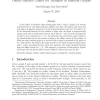Free Online Productivity Tools
i2Speak
i2Symbol
i2OCR
iTex2Img
iWeb2Print
iWeb2Shot
i2Type
iPdf2Split
iPdf2Merge
i2Bopomofo
i2Arabic
i2Style
i2Image
i2PDF
iLatex2Rtf
Sci2ools
DM
2010
2010
Online Ramsey games for triangles in random graphs
In the online F-avoidance edge-coloring game with r colors, a graph on n vertices is generated by at each stage randomly adding a new edge. The player must color each new edge as it appears; his goal is to avoid a monochromatic copy of F. Let N0(F, r, n) be the threshold function for the number of edges that the player is asymptotically almost surely able to paint before he loses. Even when F = K3, the order of magnitude of N0(F, r, n) is unknown for r 3. In particular, the only known upper bound is the threshold function for the number of edges in the offline version of the problem, in which an entire random graph on n vertices with m edges is presented to the player to be r edge-colored. We improve the upper bound for the online triangle-avoidance game with r colors, providing the first result that separates the online threshold function from the offline bound for r 3. This supports a conjecture of Marciniszyn, Sp
| Added | 10 Dec 2010 |
| Updated | 10 Dec 2010 |
| Type | Journal |
| Year | 2010 |
| Where | DM |
| Authors | József Balogh, Jane Butterfield |
Comments (0)

